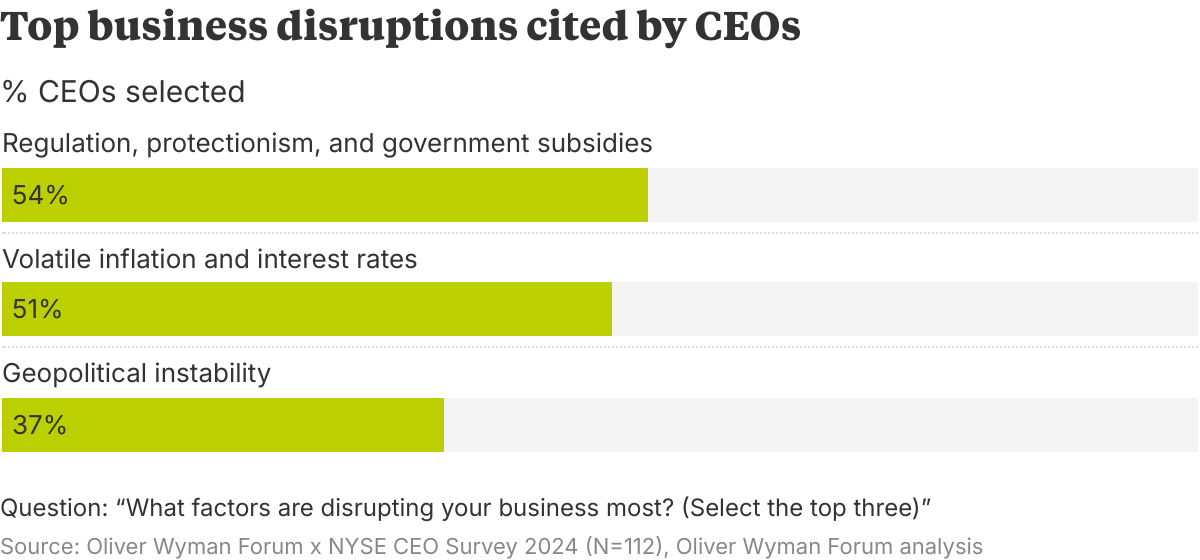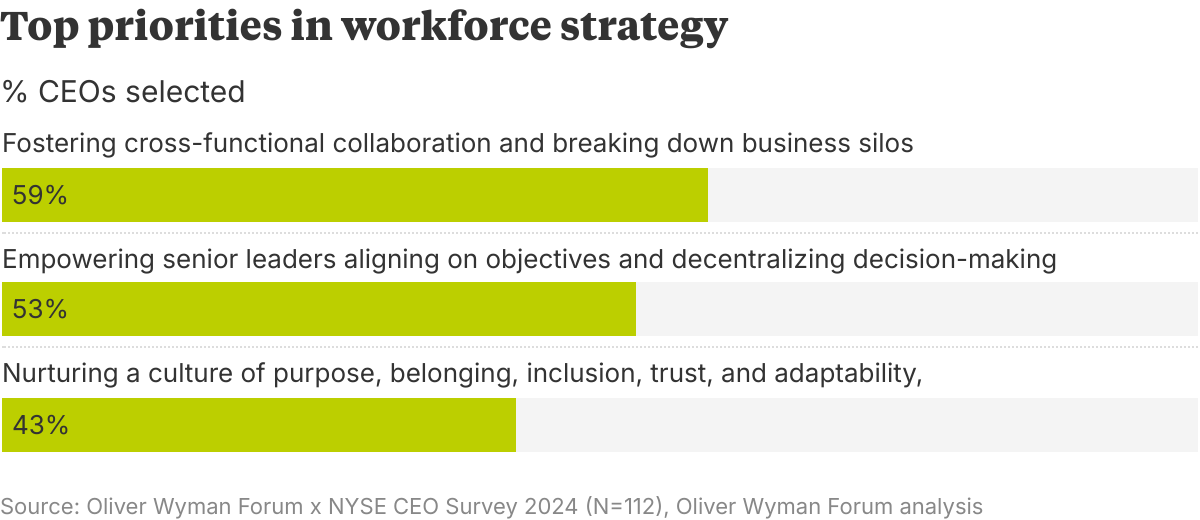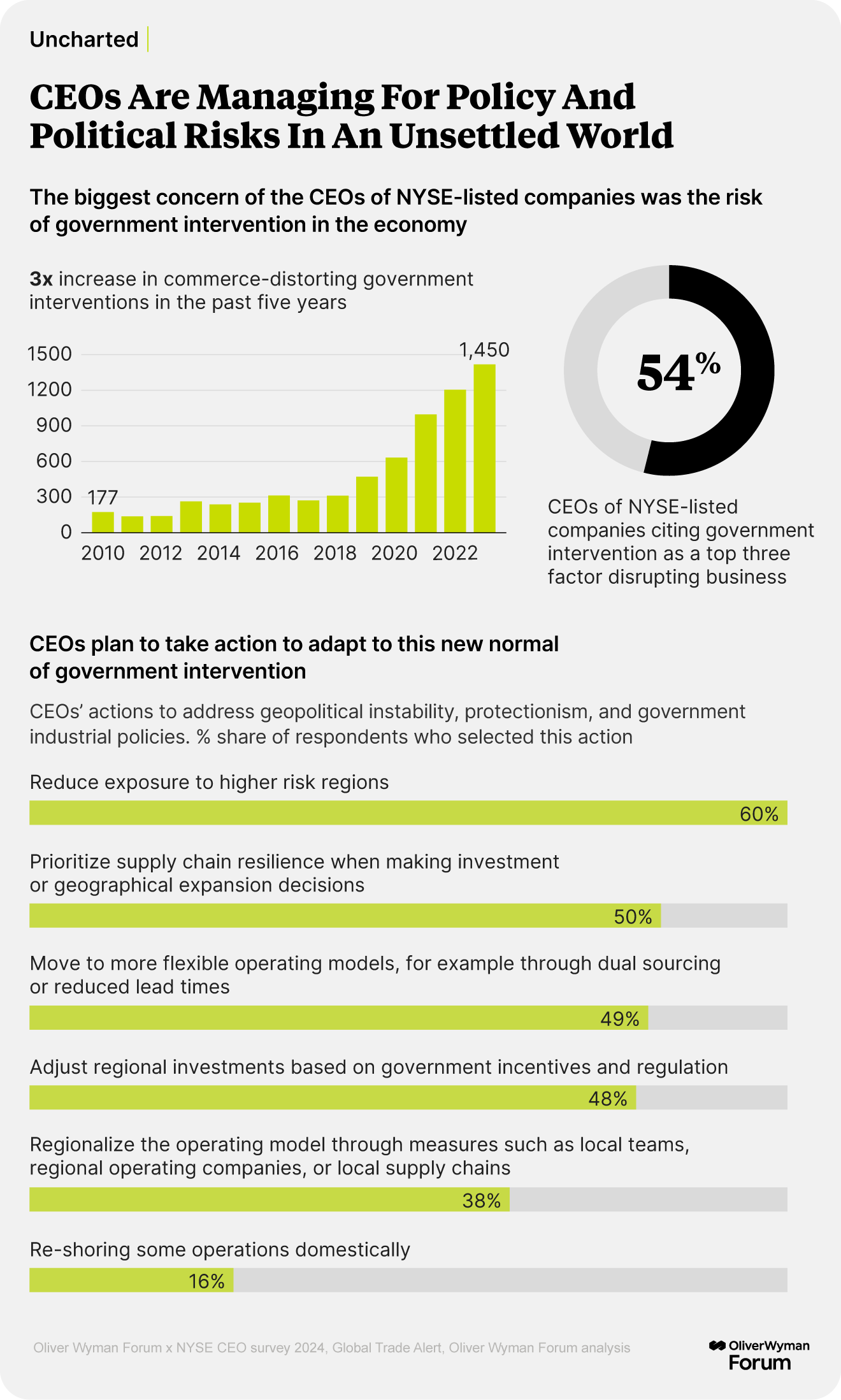Few events signal a regime shift as clearly as when former US president Ronald Reagan stood in front of Berlin’s Brandenburg Gate in 1987 and said, “Mr. Gorbachev, tear down this wall!” Two years later, the Berlin Wall came tumbling down, heralding the fall of a global order that had reigned for nearly half a century.
Today, the winds of change are threatening the status quo in the business world. Economic and geopolitical instability have upended the steady growth and open borders of globalization’s heydays, while accelerating technological change is fueling the rise of disruptive innovators that threaten incumbents.

Top-down hierarchies that organize corporate activity around product or geographic lines are no longer fit for today’s volatile world. Companies need to break down their internal walls and foster closer collaboration across the workforce to become more nimble and innovative.
Chief executives understand the new imperative. Fostering cross-functional collaboration and breaking down business siloes emerged as the top priority for workforce strategy in the Oliver Wyman Forum’s recent CEO Survey, cited by 59% of corporate bosses responding.
Saying it and actually doing it are two different things, though. Successful organizational transformation requires a strong commitment from senior management, the placing of customers at the center of the enterprise’s strategy, and measures to foster more generalist skills among the workforce.
Leadership from the top
Getting people to change the way they work — who they report to and partner with, and accelerating the pace at which projects proceed — is challenging. For people used to routine, structure, and predictability, change can be uncomfortable, even threatening.

That’s why successful change demands strong and consistent leadership from the CEO and senior management. Workers need to know that the walls are coming down for good and that cross-functional collaboration will be a lasting change, not another corporate initiative that dies in the long grass of inertia.
Leaders need to sell change with carrots, not just sticks. That means providing incentives, including compensation, to encourage collaboration and establishing a governing mechanism to prioritize where to collaborate to get the most impact.
It also means empowering managers and workers to eliminate some things from their current way of working, lest collaboration become just one more item on their to-do list to tick off. Such approaches will help workers see the personal benefit of collaborating in terms of acquiring new skills and taking advantage of new opportunities for advancement.
Put the customer at the center of everything
Many companies focus their efforts on honing existing products and processes, aiming to maximize efficiency and grow profitability. Yet this inward focus on improving what has worked in the past can blind companies to what’s needed to thrive in the future, especially at a time when technologies like artificial intelligence (AI) are changing the competitive landscape and agile disrupters are moving quickly to capture market share.
Staying close to customers and providing answers to their shifting needs and desires is the foundation of success in today’s business world. That starts by getting a deeper understanding of relevant mega-trends like the spread of AI or behavioral trends like consumer readiness to buy electric vehicles. Companies need to develop a clear view of when these trends are likely to impact their business and whether they are responding at an appropriate speed.
Then firms can test the market with strategic experiments to see if their products or solutions will fly and whether the market is ready for them. This gives companies an opportunity to learn what customers are really looking for, adjust their own solutions appropriately, and then decide whether to scale up or pivot to something else.
Foster generalist skills
Traditional organizational structures rely heavily on specialized workforces with deep knowledge of specific clients or products, discreet functions like finance or sales, or clearly defined geographies. That’s fine for stable environments, but it doesn’t enable companies to react quickly to rapid changes in economic and geopolitical conditions or technological advances.
Companies need people with more generalizable expertise to compete effectively in a disruptive environment. People with a broader range of experience and skills bring fewer assumptions to new problems and less allegiance to existing organizational siloes. Bringing together different teams to develop solutions for customers is part of their DNA. Such employees also are typically quicker to identify how changes in market conditions may challenge the existing business, and spot ways to address — and capitalize on — those changes.
To build these capabilities, leaders should champion internal mobility to nurture and promote generalist skills within the ranks. They also should evaluate their recruiting and compensation strategies to attract more of this kind of talent and facilitate continuous learning both internally and with external partnerships.
To adapt an old adage, companies need to approach today’s market environment as a relay race, not a marathon. They should build teams that can work together seamlessly and at speed to develop solutions that clients need and value. That’s a workforce strategy that can win the race.
As the buzz surrounding the potential of artificial intelligence (AI) continues to support lofty valuations of tech stocks, companies across many sectors are looking to define a clear strategy and prioritize use cases of the technology. They would do well to look at the experience of the mobility sector.
From autonomous vehicles (AVs) to airplane autopilot software to generative AI travel bookings, the industry has been an early adopter of AI. Their pioneering experience holds three lessons for other companies looking to exploit the power of AI, according to a new report from the Oliver Wyman Forum based on interviews with 20 mobility industry leaders.
Fuel AI systems with the right data
Vast amounts of information from airline flights and automobile traffic fuels AI systems that power predictive aircraft maintenance programs and autonomous driving systems. Yet companies still face challenges to effectively gather, clean, and structure data.
Other industries face similar challenges. Industrial and construction equipment operators often run fleets composed of multiple brands, making it difficult to exchange data between different technology systems.
One potential solution is using AI as a translator between different systems to aggregate and standardize data, allowing different models to communicate and work together.
Organize and form partnerships for AI
AI operating models require a particular organizational structure and experienced staff that many mobility companies simply lack. That puts them at risk of falling behind as AI adoption accelerates.
Partnering with AI providers can overcome this challenge. The growing complexity of consumer demands has forced many mobility providers to include players from other sectors with technological know-how. Funding for generative AI startups that offer enhanced in-car experiences, for example, reached $1.6 billion between 2021 and 2023, according to Oliver Wyman’s Mobility Startup Radar.
Work with regulators
A clear regulatory environment can give companies a reliable framework to test, certify, and deploy new technologies. That’s especially true for new solutions that lack established rules, like air taxis.
Consider the budding field of autonomous vehicles. Nearly half of consumers report anxieties about the underlying technology, and 64% say stricter safety protocols would make them more likely to use AVs, according to a global Oliver Wyman Forum survey.
The absence of clear regulatory frameworks poses a risk to companies, which could face costly lawsuits in the event of technology glitches. Similar regulatory uncertainty creates barriers for businesses seeking to unlock the full potential of AI. Businesses that are proactive in working with regulators can establish the right guardrails to best innovate and experiment with new technologies.
If healthcare systems buckle in a crisis, the consequences for society can be catastrophic. Just recall how hospitals overwhelmed by COVID-19 patients struggled to deliver a wide range of critical and routine care during the pandemic.
Climate change poses even greater long-term risks. A warming planet is projected to cause 14.5 million additional deaths by 2050 from floods, droughts, heat waves, and other natural disasters, and $12.5 trillion in economic losses, according to a recent study by Oliver Wyman and the World Economic Forum. Climate change also is expected to put an additional 500 million people at risk of exposure to diseases like malaria, dengue, and Zika by 2050, and increase healthcare costs by more than $1.1 trillion.
Policymakers and health industry leaders need to develop strategies now to prepare healthcare systems, workforces, and supply chains for the impact of the climate crisis, Oliver Wyman and the World Economic Forum contend in a new article. They identify three priority actions that leaders should consider.
Make local healthcare systems climate-resilient
Localities should start by conducting research and using simulation tools to assess preparedness, fortify infrastructure, and ensure provision of essential resources to limit health impacts and shorten recovery times. This local work should be backed up by cooperation and knowledge-sharing among public health systems and organizations like the World Health Organization and the US Centers for Disease Control and Prevention. Governments should conduct stress tests of public health systems, much like those implemented in the banking industry after the 2008-2009 financial crisis, and promote educational and outreach initiatives to enable citizens to take preventative health measures.
Unleash private-sector innovation
Research and development is a cornerstone of building climate-resilient health systems and uncovering new vaccines and treatments. Governments can foster this by increasing targeted research grants and reducing bureaucratic red tape, along the lines of vaccine development efforts during COVID.
Policymakers should provide clarity on innovation needs and priorities and seek to address inequities in care for low-income populations that climate change will lay bare.
Allocate resources to enable a robust global response
Success in building climate-resilient health systems depends on sustainable government funding and policies that reflect the long innovation cycles in pharmaceutical, medical device, and digital health technology. To reinforce that commitment, nations should pledge their support to addressing global health challenges and ensuring a just climate transition.
Multinational funding mechanisms and individual contributions by developed nations can bolster healthcare systems and guarantee sufficient vaccines and treatments in the developing world. Public-private partnerships and cross-sector collaborations are also essential tools to achieve these goals.
The path to building climate-resilient health systems is complex and requires coordinated actions across multiple domains. Government and industry leaders need to take action now, while there’s still time.
Every month, we highlight a key piece of data drawn from three years’ worth of consumer research.


